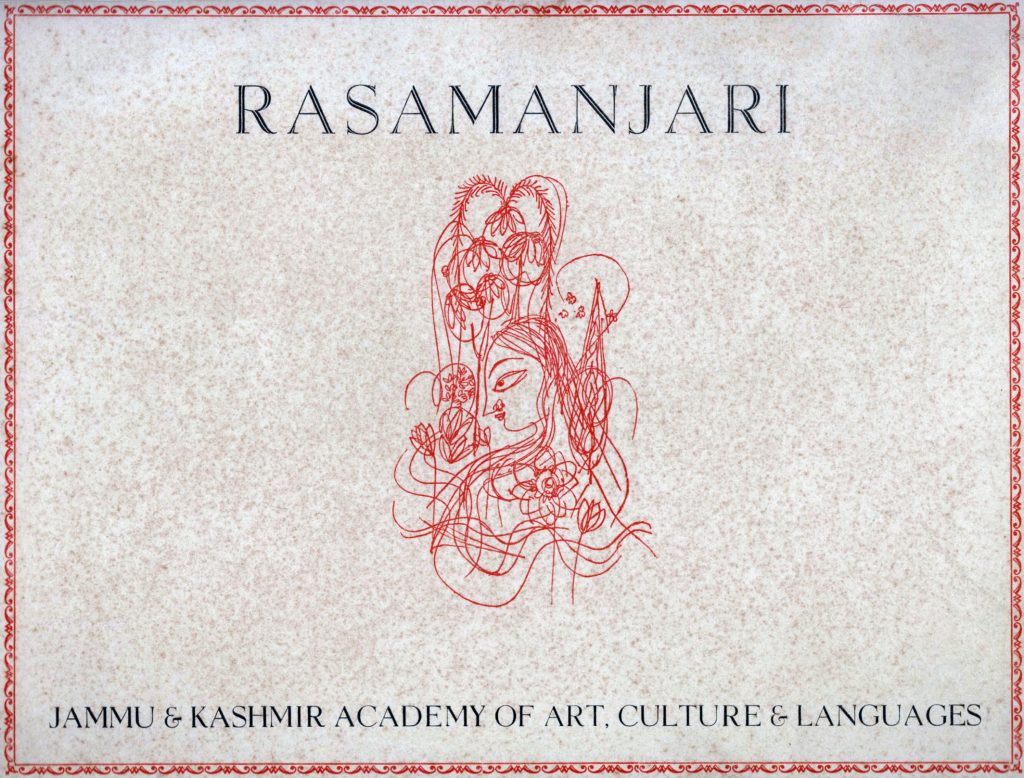Courtesy: This is original article “The Laughing Colours” by Mr. Mulk Raj Anand [1905-2004] written for Jammu & Kashmir Academy of Arts, Culture, and Languages [1969].
Of the earliest Kalam of painting in the Pahari region, namely that of Basohli, it may be said: that the dominant impression is of glowing, vibrant ‘laughing colours’. Vivid ochre, red, orange, yellow or brown for the backgrounds, lapis lazuli blue for the skyline, dark green for the dense brooding trees, and parrotbosom tenderness for the grass, burnt black for the earth, wheatbrown, pink, velvet dark, or Krishna blue, for the figures, touched off by bright gold and silver-these are the obsessional pigments to be seen when we suddenly open the cloth wrappings in which these paintings are handed to us by some survivor of the ancient little kingdom of Basohli, on the banks of the Ravi in the low hills.
Delicate tendrils trail from the willows, set off to effect by the vermillion flowers of the nearby foliage, highlighting the minute, richly painted, decorative interiors of palaces and shrines. Sharp noses and receding foreheads, big fish eyes with intense expressions, define the faces, redolent of the heightened drama of the separations and meetings of Krishna and Radha. This is the world of preparation for the union of soul,bodies through the prolonged toilets, of burning and melting, of ardent, passionate love-the symbol, through the lila (sport) of gods and goddesses, of human aspiration, yearning and possible fulfilment.
There is much speculation still about how this style suddenly emerged in the hill kingdom of Basohli.
Mr.W. G. Archer, who has written discriminatingly about the links of the various Pahari Kalams, says: ‘And although exact historical proof is still wanting, the most likely explanation is that under Raja Raj Singh, some Udaipur artists were persuaded to migrate to Basohli. We know that Rajput rulers in the Punjab hills were often connected by marriage with Rajput families in Rajasthan and it is, therefore, possible that during a visit to Udaipur, Raja Kirpal Pal recruited his
atelier.’
This speculation is not supported by any factual evidence so far. Dr. Herman Goetz suggests:
‘That Pahari painting, perhaps together with Taranath’s ‘Kashmir school’, was separated at a relatively early date from the school of the ancient west, and evolved on the basis of material originating somewhere between the Pala and Jaina miniature styles, and perhaps near to that of the Vasanta Vilasa Mss. (of the 15th century in Gujerat). On the other hand, after this, apparently influences proceeding from the Mughal Court tended to the elimination of old forms and the formation of a unified style in works, and later on dispensed with every trace of the past.’
Certainly, in the late 17th and early 18th centuries a vigorous folk style seemed to be in existence, with ‘Basohli,like’ features in the Chamba area of the Punjab hills, not far from Basohli. Dr. Goetz has reproduced some bareliefs, in wood from a palace at Brahmor. The figures here have sharp noses and receding foreheads in the Basohli manner. This home was built by Raja Prithvi Singh of Chamba (1641-1664 A.D.), but the reliefs seem to have been carved during the reign of his successor, Raja Chattar Singh, (1664-1690 A.D.). There was intimate connection between the two principalities of Chamba and Basohli at this time, because Raja Prithvi Singh was married to a princess from Basohli.
There is further evidence of the prevalence of bold folk paintings all over
the hill area, as well as of bronze images and toranas and primitive funery sculpture.
The appearance of the Mughal style Jama, or coat, with a sash on the figures in some of the earliest pictures, however, shows that it is only after the fashions in vogue at the Mughal Court were brought to Basohli that the local painters began to produce the highly stylised paintings of this kingdom, which came to be imitated in almost every hill state. There is a painting in Dogra Art Gallery Jammu, of a later period showing Raja Bhupat Pal of Basohli (1598,1635 A.D.) at the court of Shah Jehan, where he seems to have gone to pay tribute to the great Mughal. He died at sixty,two, leaving a minor heir of twelve years. This young man, Sangram Pal, who came to the gaddi in 1635 A.D., was summoned to attend the court at Delhi and soon became a favourite of the ladies in the Mughal palace through his friendship with Dara Shikoh, the eldest son of Shah Jehan. The hill Raja seems to have adopted the manners and customs of the Imperial court; and, presumably, saw the paintings of the Emperor’s atelier. He may even have brought some official albums, if not artists, from the capital to Basohli. Under his son, Raja Dhiraj Pal (1693,1725 A.D.), and the latter’s heir, Raja Medani Pal (1725,1736 A.D.) painting seems to have flourished. Later, during the puritanical rule of the anti, art Aurangzeb (1658-1707 A.D.), it is possible that a few artists from Delhi and Agra emigrated to the hill areas and helped to infuse into the sophisticated folk styles the subtlety of a more delicate draughtsmanship and the charm of softer colours and more decorative compositions.
But while the craftsmanship of the Basohli painters clearly gained a little from Mughal teaching, the content of the art remained integral to the consciousness of the indigenous Hindu revival of Vaishnavaism, which had brought back Vishnu as the Supreme God, with his various incarnations, like Krishna, into the focus of worship, through ecstatic dedication. So that, apart from a few portraits, the themes of the paintings are drawn from the extensive popular literature of the Vaishnava revival, the Gita Govinda of Jayadeva, the Bhagavata-Pmana, the Ramayana, and the Rasamanjari of Bhanu Datta.
The symbolism of the loves of Radha and Krishna also seems to have afforded the proper myths to disguise the personal predilections of the feudal princes, whose routine life in the small, sleepy kingdoms could only be heightened by the play function of the sensuous ceremonies in which they could emulate the example of the God-King, in the arcadian garden houses of their palaces, with the Rani playing the role of Radha, while the other women acted as Gopinis, in the imaginary Krishna-lila, the sport of love, played during the long evenings.
The Rasamanjari by Bhanu Datta was a delectable book of hints for lovemaking and this admirably lent itself for illustration. The hero of the various cantos is Rasa, the flavour of love; and the various moods of catharsis are described through the classification of the erotic inclinations of heroes and heroines called the Nayaka Nayika Bheda.
It seems that Raja Kirpal Pal (1678-1693 A.D.) asked his painters to introduce the figure of Krishna to symbolise the hero in the illustrations to this book, which actually makes no mention of the love God of Brindaban. This may have been done to make the paintings respectable in the midst of an orthodox society.
At any rate, it became a favourite text for the painters. And there are three extant series of paintings on the variegated emotions described in the poem.
The first of these versions of the Rasamanjari m pictures is in the Boston Museum, and is ascribed by Mr. W. G. Archer to circa 1680 A.D. This is said to be the earliest version on stylistic grounds.
The second series is distributed in two collections. Some pictures are in the Bharat Kala Bhavan, Banaras and some are in the Dogra Art Gallery, Jammu. Dr. M. S. Randhawa believes rightly that the Jammu set is ‘mixed’.
The third series, which is divided between two owners, namely the Wazir family of Nurpur and Kasturbhai Lalbhai of Ahmedabad, is supposed to have been painted at Nurpur.
We have chosen below some paintings from the Rasamanjari series of the Dogra Art Gallery. The whole of this set has not yet been reproduced, but Dr. M. S. Randhawa, who first noticed them in 1957, has paid attention to some of the pictures in Roopa,Lekha. He has had the Sanskrit text of Bhanu Datta rendered into English.
The notes given in the present text mainly concentrate on the pictorial situation of each painting.
The fact that the set in the Dogra Art Gallery was, until a few years ago, in the possession of Panda Kunj Lal, a descendant of the Royal physicians of Basohli, makes it one of the few authentic series which were painted in the capital of the extinct kingdom. And the quality of brushwork of the typical Basohli Kalam, with the ripeness of ‘laughing colours’ can be seen here in its mature phase, in a refined primitivism which is heartwarming.
The exact dates when the paintings were done have been mentioned in the inscription on the colophon of the series in the Bharat Kala Bhavan. We quote this here from a rendering by the late Pandit Hiranand Shastri:
‘In order to see the creation of God and to realise the hollowness of the world this (Chittarasamanjari), containing many pictures, (which are) the wealth (in creation) of mind, was caused to be prepared by Raja Kirpal Pal. It was completed on the auspicious day, the seventh tithi of the bright fortnight of [Magha] in the Vikrama year (which is) counted by the eyes, the arrows, the sages and the moon, i.e. 1752 in the town called Visvathati (Basohli) which lies on the beautiful banks of the ArieYati (Ravi), by Devidasa, who is well versed in the art of painting.’
Ostensibly, then, the work was commissioned by Raja Kirpal Pal (1687;1693 A.D.) but finished a couple of years after his death.
The essence of the Basohli style is what may be called its expressionism, in the meaning of that term as the enactment of imaginative dramatic episodes in paint to secure spiritual effects. Even as the poets took the most intense moments in the prolonged search of the body for the soul, so the painters painted the figures in action, in high contrasting colours, symbolising the absolutist yearnings of the loYers. The passion;play is thus portrayed in primary red,hot colours, which evoke the exalted world of love itself, the firmament lifted above all mundane considerations into the final ecstasy of belonging, for direct contact with Love. Thus technique is only a partial consideration. As against Mr. Ajit Ghose and the other early critics who say that the treatment of landscape in Basohli paintings is ‘decorative’, I would be inclined to suggest that, even at the cost of crudity, nothing extraneous is introduced in these paintings which is not integral to the intense moment of the drama. In fact all the elements are used, symbolically, to urge the senses on towards the total realisation of the picture. The Bharata,Natya, Shastra’s signification of colours, mentioned in the 2nd century B.C., ascribed the Sringara, or the erotic, mood to dark brown; the hasya joviality, to white; Karuna or pity to grey; Raudra or fury to red; Vira, the heroic mood to fair complexion; Bhayanka or terror to black; Vibhatsa or the odious to indigo blue; and Adhbuta or the marvellous to yellow. These symbolic colour meanings had more or less survived into the late mediaeval period, though Basohli uses pigments more importantly for heightening the drama than almost any other Kalam, except Mewar in Rajasthan. The inner suggestion for the desire for togetherness is further emphasised by the painting of a pair of birds together in the picture, which shows the heroine forlorn. A snakelike wisp of cloud emphasises the mood of the lover, who asks the beloved why she is trembling: … ‘You whom even the snakes could not frighten on the way, now tremble at the mere touch of my hand. The thunder, ing clouds could not shake you, and yet you turn away at a mere word of love … ‘ The round trees are dense dark green, to express the heavy brooding nature of love in separation. The mango is the parallel of firm juicy breasts of the woman. The cypress tree suggests maleness. Lyrical willows appear where the lovers are happy in the grace of union. The presence of flasks, wine cups and fruit laden plates, indicate the banquet of the nuptial night. The lotuses represent calm as they stand in the pools. The lovers are always shown as the epitome of bursting youth, whose gay costumes are contrasted to the pain of longing, as the heroines go in dark nights through snake and demon,infested landscapes, under skies torn by lightning. The semi,nudity of the :figures shows that the lure of physical love was deliberately exalted. The celebration of the drama of the sensuous life, with the raging storms in the devoted hearts, compelled to seek each other, inspite of misunderstandings, jealousies, suspicions of treachery and other people’s trouble,making, is portrayed through warm-blooded, animated heroes and heroines in this Basohli Rasamanjari. And we are initiated into the insights of our own buoyant supplications for the absolute felicities of the world of desire, with its inevitable heartaches.









Congratulations to Prof Lalit Magotra and all the members of DOGRI SANSTHA for creating and launching such a useful website. Another feather in its cap.
शुभकामनाएं आस्तै शुक्रिया , प्रो. मीनागी जी । असेंगी तुं’दे सुझाएं ते फ़ीडबैक दी निहालप रौह्ग ।
kindly oblige and send good resolution photos for our special issue on jammu so that we may republish this article. and any other material.
poonam singh
editor preet lari
preetlarhi@gmail.com
whatsapp 7347642206
Can anyone provide me the Rasmanjri by Mulk Raj Anand
You may request at dogri.sanstha@gmail.com